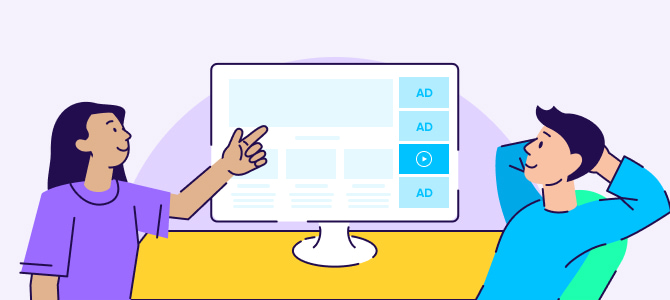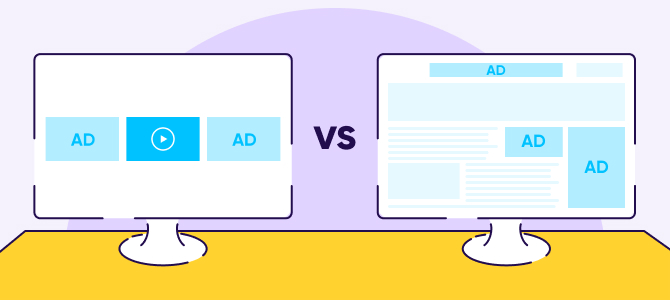
Ad podding

An advertising strategy that involves grouping multiple ads and playing them back-to-back during a single ad break, ad podding is used by OTT platforms and content publishers to maximize fill rates and revenue.
What is ad podding?
Placing multiple ads together and playing them one after the other during a single ad break, so that publishers don’t have to send numerous requests to serve different ads to the same viewer.
You can use ad podding for pre-roll, mid-roll, and post-roll ads.
Ad podding is similar to commercial breaks on traditional TV that play ads back-to-back. The only difference is that it’s used for video content on OTT platforms — and is particularly valuable for long-form video on demand (VOD) content.
The origin of ad podding
The Interactive Advertising Bureau (IAB)’s VAST 3.0 first introduced the concept of ad podding in 2012. While the initial adoption was slow, OTT service providers and content owners quickly realized its potential, allowing it to gain even more traction when YouTube started implementing it in 2018.
Today, established OTT platforms use it to optimize ad inventory and generate more revenue from VOD and live streaming content.
Ad pods vs. ad slots

Ad slots are the individual units that make up a pod, with each slot having a pre-assigned sequence number that determines when it will be played.
You can invite bids for each ad slot in a pod to demand comparatively higher prices for premium slots (for example, the first slot).
How does ad podding work?
To the viewer, ad podding looks as simple as a series of ads played one after the other, but a lot goes on behind the scenes to ensure a frictionless viewing experience.

Here’s a step-by-step overview of how ad podding works for OTT platforms:
- The publisher uses a video CMS to set up multiple ad tags, each representing a single slot in the pod. They can insert the tags through CSAI (Client-Side Ad Insertion) or SSAI (Server-Side Ad Insertion).
- All individual ad tags are assigned unique sequence numbers.
- When a viewer plays a video, the player makes ad calls for each tag based on its sequence number.
- If the call is successful and returns an ad that fits into the slot, the player serves it.
- If the call comes back empty or returns an ad that doesn’t fit into the slot (e.g. a 30-second ad for a 60-second spot), the player moves to the following tag in the sequence.
- If none of the tags in a pod fit the requirements, the player can play a standalone or non-sequenced ad.
Ad podding lets you queue up as many tags as you want in a pod. You can also customize the duration of pods and slots, and allow viewers to skip ads after watching the first one.
Why is ad podding important?
1 – It helps you to increase revenue
With podding, you can serve multiple ads in a single request. This reduces the number of calls, which helps maximize the ad fill rate.
You also have complete control over the pricing of each slot, meaning you can demand a higher fee for premium placements, such as the first ad slot in a pod.
Doing so can help harness the full potential of the available ad inventory and boost your revenue.
2 – It enhances your users’ viewing experience

Without podding, you’d be sending multiple requests within an ad break, which would all exist in silos.
This could result in the same ad playing multiple times during a break, which would lead to a frustrating viewing experience and may drive your potential customers away.
Modern podding solutions use techniques like creative deduplication to prevent the same ad from running twice in a pod. It also gives you complete control over the number of ads you want to include in a pod and their duration.
These parameters can be customized based on your viewers’ preferences to create a more engaging ad-watching experience.
The viewing experience is further enhanced by the lower latency and shorter loading times, as ads are served using a single request.
3 – It makes advertisers happy
With podding, advertisers get a closer look at your inventory and have more control over ad placement, as they can choose the slot in a pod that’s right for them, based on their budget and other requirements.
Nowadays, ad podding solutions use competitor separation to prevent ads in the same IAB product category from running in a pod, making ad breaks diverse and interesting.
It also helps advertisers emphasize their message more effectively as they don’t have to compete with other brands to grab viewers’ attention.
As a result, it enhances the performance and ROI of their ad campaigns, creates a win-win situation for publishers and advertisers, and helps foster long-standing partnerships between them.
Ad podding customization
Typically, ad podding solutions let you customize the following parameters:
- Length of a pod
- Number of ads within a pod
- Duration of each ad within a pod
To decide how to customize these, use an ad analytics solution that collects data on user behavior and viewing preferences. For instance, you can find out whether viewers watch all ads in a pod or skip the last two, which could signify you might have too many ads in a single pod.
Similarly, you can find out if they’re more likely to skip mid-roll ads than pre-roll ones, which could indicate ad fatigue.
You can even compare viewing statistics for ads of different lengths, to be able to determine the ideal duration to use.
Ad pods bidding
As with other ad formats in OTT advertising, ad podding requires publishers to auction their ad inventory using various techniques, such as programmatic guaranteed, preferred deals, open auctions, etc.
This bidding can be placed for both ad slots and pods. Advertisers can choose to go for per pod bidding to explore the whole pod in a single bid request and gain more control over ad placement — as opposed to per slot bidding, which only helps explore a single slot.
On the other hand, publishers can set floor prices for each slot in a pod (higher prices for premium slots) to create better monetization opportunities and pump up their revenue.
When publishers should NOT use ad podding
Ad podding may not always be the best monetization strategy for publishers. It works better for long-form VOD and live streams, as the break is shorter compared to the content duration.
That said, if your content library mostly features short-form content, longer ad breaks could annoy viewers — so running a single ad would be wiser.
Also, if you’re using other monetization models, such as subscriptions or paywalls to generate revenue, it doesn’t make sense to use ad podding.
Key takeaways
- The concept of ad podding was first introduced in IAB’s VAST 3.0 in 2012.
- Podding involves grouping multiple ads and playing them back-to-back in a single ad break. It creates an experience similar to commercial ad breaks on traditional TV. The only difference is that ad podding is used on OTT platforms and gives publishers a lot of control over the ads.
- OTT service providers and content owners can use podding to maximize revenue from their existing ad inventory.
- Techniques like creative deduplication and competitor separation ensure a frictionless viewing experience while boosting ad performance, ensuring advertisers achieve better ROAS, and letting publishers build long-term relationships with them.
- Ad podding is better suited for long-form content (on-demand and live) but isn’t an ideal option for short-form content.



